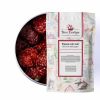



How to Use Wiri Wiri Chilli Pepper in Cooking?
Some recommendations regarding the Wiri Wiri chilli pepper
The Wiri Wiri chilli pepper is an extremely powerful chilli, so it is necessary to take certain precautions when using it. Avoid handling it with bare hands, and prefer to use gloves. If you don't have gloves available, avoid touching your mouth, lips, or eyes. After handling the chilli pepper with bare hands, wash your hands thoroughly.
How to Use the Wiri Wiri Chilli Pepper According to the Desired Spiciness?
As with other chillies, the spiciness of the Wiri Wiri chilli pepper is concentrated in the seeds.
For a moderate spiciness in your dishes, you can use it whole or remove the seeds and internal membranes to incorporate the flesh into your preparations.
If you want to add a very powerful spiciness to your dishes, you can chop it into fine pieces while keeping the seeds. You can also dry it in the oven for 30 to 45 minutes and then grind it to obtain a chilli powder.
Our suggestions to spice up your kitchen with Wiri Wiri chilli pepper
The Wiri Wiri chilli pepper holds a prominent place in traditional Guyanese cuisine. It is used in traditional dishes like pork colombo. It also finds its place in Creole dishes like accras, chicken skewers, or Creole fritters.In everyday cooking, the Wiri Wiri chilli pepper can be used in soups, simmered dishes, sauces, and marinades to add dynamism to your recipes. It can also season a salad like spicy green mango salad or be used in a spicy oil.
The Aromas of Wiri Wiri Chilli Pepper
The Wiri Wiri chilli pepper is a volcanic chilli. It has tomato aromas, which makes it quite unique. It is also surprising with its fruity and tangy flavor. Its appearance resembles a cherry tomato, hence the nickname "cherry pepper." Its spiciness is rated 10/10 (explosive) on the Scoville scale, as it is very rich in capsaicin.
Wiri Wiri Chilli Pepper and Its Botany
Botanical and Geographical Origin of Wiri Wiri Chilli Pepper
The botanical name of the Wiri Wiri chilli pepper is Capsicum frutescens, belonging to the same botanical species as the Cayenne pepper.
However, it should be noted that its spiciness is much stronger than that of Cayenne pepper. The Wiri Wiri chilli pepper is native to Guyana.How Do Wiri Wiri Chillies Grow?
The cultivation of Wiri Wiri chilli peppers requires specific climatic conditions: a hot and humid climate at the edge of the tropical forest. These requirements limit the production of this chilli pepper, unlike the Cayenne pepper, which is easier to grow and, therefore, more well-known.
This chilli pepper grows vertically and turns bright red when it reaches maturity. After harvesting, it dries for a few days in the sun. This is what gives it the wrinkled appearance and a resemblance to a dried tomato.
Culture and History of Wiri Wiri Chilli Pepper
The history of the Wiri Wiri chilli pepper is relatively unknown, but its cultivation and use seem to be ancestral. Despite difficult production, the use of this chilli pepper is an integral part of the local culture. According to locals, consuming it is even believed to promote well-being and longevity.
Click here to learn more about chillies
| Allergen | Absence |
|---|---|
| Native country | EQUATEUR |
| Genus and botanical species | Capsicum frutescens |
| Ingredients | wiri wiri chilli pepper |
| TRACES EVENTUELLES D'ALLERGÈNES | céleri, sésame, moutarde, fruits à coques. |
 Français
Français 